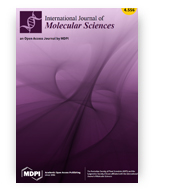New Oxazolo[5,4-d]pyrimidines as Potential Anticancer Agents: Their Design, Synthesis, and In Vitro Biological Activity Research
Aleksandra Sochacka-Ćwikła; Marcin Mączyński; Żaneta Czyżnikowska; Benita Wiatrak; Izabela Jęśkowiak; Albert Czerski; Andrzej Regiec
International Journal of Molecular Sciences
Ministerial score = 140.0
Journal Impact Factor (2022) = 6,208 (Q1)
 Cancer is a large group of diseases in which the rapid proliferation of abnormal cells generally leads to metastasis to surrounding tissues or more distant ones through the lymphatic and blood vessels, making it the second leading cause of death worldwide. The main challenge in designing a modern anticancer therapy is to develop selective compounds that exploit specific molecular targets. In this work, novel oxazolo[5,4-d]pyrimidine derivatives were designed, synthesized, and evaluated in vitro for their cytotoxic activity against a panel of four human cancer cell lines (lung carcinoma: A549, breast adenocarcinoma: MCF7, metastatic colon adenocarcinoma: LoVo, primary colon adenocarcinoma: HT29), along with their P-glycoprotein-inhibitory ability and pro-apoptotic activity. These oxazolo[5,4-d]pyrimidine derivatives, which are structurally similar to nucleic purine bases in general, are characterized by the presence of a pharmacologically favorable isoxazole substituent at position 2 and aliphatic amino chains at position 7 of the condensed heterocyclic system. In silico analysis of the obtained compounds identified their potent inhibitory activity towards human vascular endothelial growth factor receptor-2 (VEGFR-2). Molecular docking was performed to assess the binding mode of new derivatives to the VEGFR-2 active site. Then, their physicochemical, pharmacokinetic, and pharmacological properties (i.e., ADME—administration, distribution, metabolism, and excretion) were also predicted to assess their druglikeness. In particular, compound 3g (with a 3-(N,N-dimethylamino)propyl substituent) was found to be the most potent against the HT29 cell line, with a 50% cytotoxic concentration (CC50) of 58.4 µM, exceeding the activity of fluorouracil (CC50 = 381.2 μM) and equaling the activity of cisplatin (CC50 = 47.2 µM), while being less toxic to healthy human cells (such as normal human dermal fibroblasts (NHDFs)) than these reference drugs. The results suggest that compound 3g is a potentially promising candidate for the treatment of primary colorectal cancer.
Cancer is a large group of diseases in which the rapid proliferation of abnormal cells generally leads to metastasis to surrounding tissues or more distant ones through the lymphatic and blood vessels, making it the second leading cause of death worldwide. The main challenge in designing a modern anticancer therapy is to develop selective compounds that exploit specific molecular targets. In this work, novel oxazolo[5,4-d]pyrimidine derivatives were designed, synthesized, and evaluated in vitro for their cytotoxic activity against a panel of four human cancer cell lines (lung carcinoma: A549, breast adenocarcinoma: MCF7, metastatic colon adenocarcinoma: LoVo, primary colon adenocarcinoma: HT29), along with their P-glycoprotein-inhibitory ability and pro-apoptotic activity. These oxazolo[5,4-d]pyrimidine derivatives, which are structurally similar to nucleic purine bases in general, are characterized by the presence of a pharmacologically favorable isoxazole substituent at position 2 and aliphatic amino chains at position 7 of the condensed heterocyclic system. In silico analysis of the obtained compounds identified their potent inhibitory activity towards human vascular endothelial growth factor receptor-2 (VEGFR-2). Molecular docking was performed to assess the binding mode of new derivatives to the VEGFR-2 active site. Then, their physicochemical, pharmacokinetic, and pharmacological properties (i.e., ADME—administration, distribution, metabolism, and excretion) were also predicted to assess their druglikeness. In particular, compound 3g (with a 3-(N,N-dimethylamino)propyl substituent) was found to be the most potent against the HT29 cell line, with a 50% cytotoxic concentration (CC50) of 58.4 µM, exceeding the activity of fluorouracil (CC50 = 381.2 μM) and equaling the activity of cisplatin (CC50 = 47.2 µM), while being less toxic to healthy human cells (such as normal human dermal fibroblasts (NHDFs)) than these reference drugs. The results suggest that compound 3g is a potentially promising candidate for the treatment of primary colorectal cancer.
DOI:10.3390/ijms231911694









